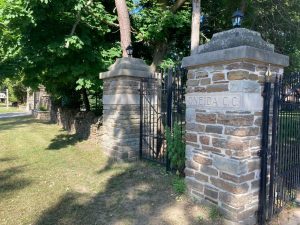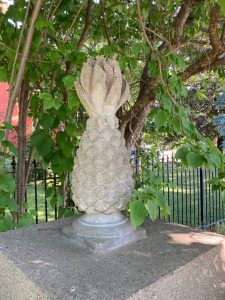I recall many years ago spying the stone pineapples along Mississauga Road and being intrigued by this curiosity. Together with the stone gate posts and dry-stone walls, they seemed to harken back to a landscape from yesteryear.
First, it is hard to date stone walls. As you travel along Mississauga Road south of Dundas Street, you will find sections of low stone walls. A closer look will reveal that there are several different walls, and in some cases these walls abut each other. But although they share common methods of construction, they were built at different times. The oldest section of wall likely belongs to the mid-1920s and the Arcadia estate of J.P Bickell. Other nearby owners added their own styles of walls, including that of the Oak Ridge Farm of William George Dean in the late 1920s, and the Glades of Fleet from Roy Thomson Sr. and the IALFA estate from Isabelle and Alexander Fasken in the 1930s.
walls, and in some cases these walls abut each other. But although they share common methods of construction, they were built at different times. The oldest section of wall likely belongs to the mid-1920s and the Arcadia estate of J.P Bickell. Other nearby owners added their own styles of walls, including that of the Oak Ridge Farm of William George Dean in the late 1920s, and the Glades of Fleet from Roy Thomson Sr. and the IALFA estate from Isabelle and Alexander Fasken in the 1930s.
But back to the pineapples.
Richard De Boo (1896-1970), a noted Toronto-based publisher, purchased 47 acres of the former Fasken Estate in 1957 with the intent of opening a country club. In 1950 and 1954, Richard and his wife Edythe De Boo had purchased additional acreage on both sides of the river. They had built their home on the east side of the river, where Oneida Court is today along the south side of The Queensway.
An article in the Port Credit Weekly on July 18, 1957, announced De Boo’s intention to create what became the Oneida Country Club, consisting of 75 acres, located a short distance north of the Mississaugua Golf and Country Club on Mississauga Road, on the west side of the Credit River.
 The Fasken Estate already featured an expansive estate house that had been built circa 1920. This house was converted and became the main club house for the Oneida Country Club. The property also featured low stones walls and an ornamental gate emblazoned with IALFA, denoting the former Fasken property. De Boo had matching gate posts added that showcased Oneida C.C. (these survive today), and a new ornamental entrance to the country club. As part of this, stone pineapples were also added and reportedly became the symbol of the Oneida Country Club.
The Fasken Estate already featured an expansive estate house that had been built circa 1920. This house was converted and became the main club house for the Oneida Country Club. The property also featured low stones walls and an ornamental gate emblazoned with IALFA, denoting the former Fasken property. De Boo had matching gate posts added that showcased Oneida C.C. (these survive today), and a new ornamental entrance to the country club. As part of this, stone pineapples were also added and reportedly became the symbol of the Oneida Country Club.
The pineapple was a fitting symbol for what De Boo was envisioning. Historically the pineapple, in Europe and North America, was a showcase for exclusivity, wealth and aristocracy. As pineapples became more readily available after the Second World War, it developed additional symbolism. It became seen as a sign of welcome, neighbourliness and hospitality. De Boo’s establishment catered to both elements – wealth and hospitality.
The Oneida Country Club was geographically situated between two older clubs – the Mississaugua Golf & Country Club and the Credit Valley Golf Club. But Oneida sought to be something different. While Oneida did have a relatively small 9-hole golf course, it also featured tennis, swimming, horse-back riding and skiing, not to mention the expansive club house which catered to social activities, large meetings, and weddings. Oneida advertised itself as an exclusive social club, and was in operation between 1957 and 1969. At its height, Oneida had a membership of over 300 groups. Ill health led to Richard De Boo selling the Oneida Country Club to Leonard Finch and the United Lands Corporation in 1969. Oneida quietly closed its doors in early October of 1969. A portion of the Onedia lands were acquired by the Credit Valley Golf Club, and other areas were subdivided for development. The Oneida club house, which had been built by the Fasken family as a private home, reverted to a private residence, and remains today. As do the some of the stone walls and stone gate posts.
different. While Oneida did have a relatively small 9-hole golf course, it also featured tennis, swimming, horse-back riding and skiing, not to mention the expansive club house which catered to social activities, large meetings, and weddings. Oneida advertised itself as an exclusive social club, and was in operation between 1957 and 1969. At its height, Oneida had a membership of over 300 groups. Ill health led to Richard De Boo selling the Oneida Country Club to Leonard Finch and the United Lands Corporation in 1969. Oneida quietly closed its doors in early October of 1969. A portion of the Onedia lands were acquired by the Credit Valley Golf Club, and other areas were subdivided for development. The Oneida club house, which had been built by the Fasken family as a private home, reverted to a private residence, and remains today. As do the some of the stone walls and stone gate posts.
Richard Willard De Boo passed away on June 29, 1970. His obituary lists that he was laid to rest in the Mount Hermon Cemetery in Quebec.
But his stone pineapples remain.



Comments are closed.